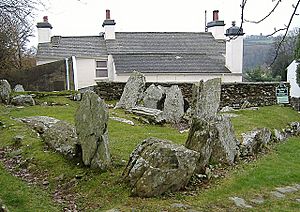King Orry's Grave facts for kids

King Orry's Grave seen from the north
|
|
| Location | Isle of Man |
|---|---|
| Coordinates | 54°13′53″N 4°23′47″W / 54.231413°N 4.396447°W |
| OS grid reference | SC 43894 84396 |
| Altitude | 79 m (259 ft) |
| Type | Chambered cairn |
| History | |
| Periods | Neolithic |
| Site notes | |
| Excavation dates | 1930 |
| Ownership | Manx National Heritage |
| Public access | Yes |
King Orry's Grave is the biggest ancient burial site on the Isle of Man. It's a huge stone tomb, also known as a megalith, built thousands of years ago. You can find it in Minorca, a small area in the northern part of Laxey village. Part of it is even in someone's private garden!
This amazing site is between 4,000 and 5,000 years old. The name "King Orry" refers to an 11th-century ruler named Godred Crovan. However, the tomb is much older than him. The name "King Orry's Grave" probably became popular in the early 1800s. Today, King Orry's Grave is looked after by Manx National Heritage.
What is King Orry's Grave?
This ancient tomb is from the Neolithic period, also known as the New Stone Age. It's a special type of tomb called a Clyde cairn. This means it has several burial rooms. The tomb is made from colorful sandstone.
The Eastern Part of the Tomb
The eastern section of the tomb faces northeast. It's shaped like a half-circle, about 12 meters (39 feet) wide and 4 meters (13 feet) deep. This part has three separate burial chambers. These chambers were once covered by a trapezoid-shaped pile of stones, called a cairn.
There's also a U-shaped area at the front, called a forecourt. This forecourt has large stone slabs and walls made of dry stone. Two tall stones, called portal stones, stand at the entrance. It's thought that this part of the tomb might have been even bigger. However, some of it was destroyed in the 1800s when a road and a house were built.
The Western Part of the Tomb
At the western end of the site, there's another separate stone structure. This part was dug up by archaeologists in 1930. It includes a cist, which is a small stone box or coffin, and a menhir, which is a tall, upright stone.
It's not clear if this western part was originally connected to the eastern section. Modern houses built nearby make it hard for archaeologists to dig and find out more. The huge stone slabs used to build the chambers came from local areas. Later, another chamber was added, along with a horseshoe-shaped forecourt at the southwest end.
Most of the original standing stones are now just stumps. Only one tall stone remains. These standing stones were likely part of a large cairn of rubble that covered the burial chambers. Similar tombs can be found in northern Ireland and southwest Scotland.


